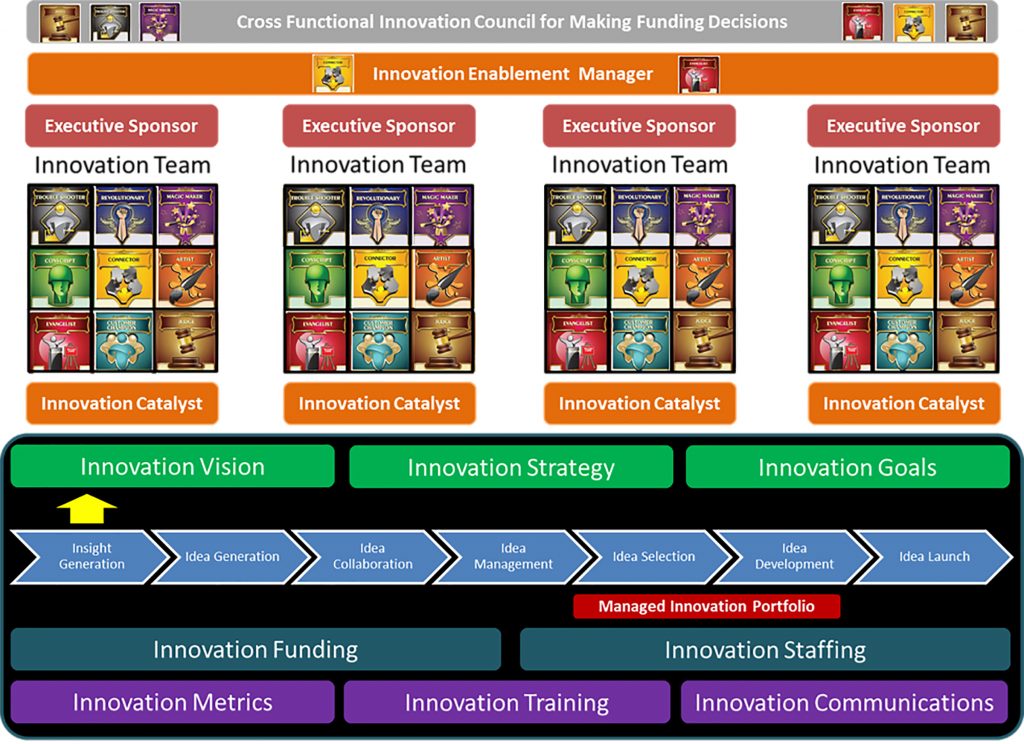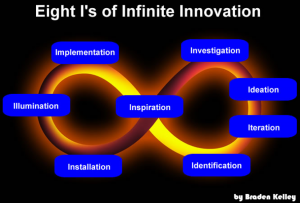Building a company is not as simple as having the right amount of money. More than having a business plan, creating a powerful company culture is very important. Braden Kelley shares to us secrets of building an effective culture of continuous innovation. Curious? Read on to know more.
Every company begins as the nimble startup, organised around the solution to a single customer problem and executing that solution better than anyone else in the market (including incumbents with deep pockets). But this emerging leader soon becomes a follower as the organisation evolves and scales into a more complex (but capable) next generation incumbent. Inevitably, every growing organisation finds itself so focused on capturing all of the business for its existing solutions, that it finds itself becoming disconnected from evolving customer preferences.
The companies that last the longest manage to fulfil existing customer needs with well-delivered solutions, and identify new customer needs to satisfy as customer preferences continue to shift. But many large or growing companies fail to do so quickly enough, especially in our new digital reality where it is easier than ever to start and scale a solution around the globe with limited resources. Innovation is the key to remaining relevant with customers. Winning the War for Innovation is the key to remaining alive.
Building an Infinite Innovation Infrastructure
This quest to win the war for innovation has led many organisations to stand up dedicated innovation departments staffed with all kinds of different innovation leaders. Sometimes companies move these teams across the country or around the world in an attempt to locate them next door to innovative companies they admire, hoping some of their success will rub off. In other cases they build colourful, open plan creative spaces in a desperate attempt to recreate some of the perceived innovation mojo of Internet giants.
But building a fancy innovation space on top of a shoddy innovation foundation will only lead to this new innovation structure collapsing under its own expectations. So, don’t do this. Instead focus on building an Infinite Innovation Infrastructure (see Figure 1). The foundations of which include:
1. Working with senior leadership (and even the Board of Directors) to establish a shared understanding of what innovation is (AND ISN’T) – create a shared definition
2. Securing public commitment from senior leadership to support innovation on an ongoing basis, and internal clarity on how it will differ from new product development (NPD), and research and development (R&D)
3. Getting dedicated funding for discrete innovation experiments
4. Creating an innovation vision to set the agreed parameters for your innovation efforts
5. Creating an innovation strategy that ideally links to your corporate strategy
6. Creating innovation goals and metrics that will allow you to create targets for success and an ability to measure your progress towards them
Your goal is to move people beyond viewing innovation as a project, and towards viewing innovation as a process and a capability that the organisation needs to build to survive (like good governance or operational excellence).
Source: Braden Kelley 2013
Figure 1: Infinite Innovation Infrastructure
And this process or capability should be built by a team that is seen not as the people responsible for innovating, but instead as the people responsible for enabling innovation, encouraging it, inspiring it, facilitating it, and coordinating it. In short, what you are looking to build is an innovation enablement team that can facilitate the Seven C’s of a Successful Innovation Culture:
1. Cultivating a Culture of Curiosity – Curiosity drives innovation, and so the more curious people you have in your organisation, the more innovation you are going to be able to generate. A good team can help cultivate a culture of curiosity. Amplifying curiosity in your organisation is one of the most important improvements you can make in your culture.
2. Collection of Inspiration and Insight – Curiosity is driven by inspiration and insight, and a good innovation enablement team excels at collecting and sharing inspiration and insight. This can include teaching people inspiration gathering frameworks like the Four Lenses of Innovation and idea generation methods like SCAMPER.
3. Connections – Innovation is about collecting and connecting the dots. A good team builds connections inside (and outside) the organisation that help to accelerate the gathering and dissemination of inspiration and insight. Innovative organisations increasingly turn their attention outwards for innovation, recognising that there are more smart people outside the organisation than inside, and build the necessary bridges to connect to where they live.
4. Creation – The innovation enablement team works across the organisation to help remove barriers to innovation and to enable others. This includes providing a set of tools and methodologies for creative problem solving and other aspects of innovation work, organising events, and other activities that support deepening capabilities across the Seven C’s of Successful Innovation Culture and helps people cope with all of the associated change by leveraging the Change Planning Toolkit™ introduced in my book Charting Change.
5. Collaboration – A good team will know when to create a new innovation in-house, when to partner with an external entity like a University, startup, supplier, or other organisation, and when to license a piece of technology or to acquire another company or startup in order to realise the desired innovation result for the company’s customers. A good innovation team also knows how to leverage the power of the Nine Innovation Roles to maximise team potential.
6. Commercialisation – Your team is there not to shepherd a single potential innovation project from insight to market, but to build a sustainable, continuous source of innovation, and a culture that reinforces your method for creating continuous innovation. One tool I’ve created for all types of innovation teams is the Eight I’s of Infinite Innovation™, which as you can see, places inspiration at the centre of looping, infinite process (see Figure 2).
Source: Braden Kelley 2013
Figure 2: Eight I’s of Infinite Innovation
7. Communications – A good team excels at helping to define AND consistently communicate and reinforce the organisation’s common language of innovation. Several companies have used my book Stoking Your Innovation Bonfire to help build their common language of innovation. Good innovation teams also act as a coach, supporting emergent innovation, and helping people test and learn, prototype and find the right channel to scale the most promising insight-driven ideas (or work with the organisation to create new channels).
Ultimately, the responsibility for innovation should remain with the business, under an innovation vision, strategy and goals set by the CEO and senior leadership. It’s okay to bring someone in from the outside to help get things off to a strong start, to build a strong foundation, and to set your innovation enablement team up for success.
[ms-protect-content id=”9932″]Innovation Sits at an Intersection
In building an Infinite Innovation Infrastructure we create the conditions for innovation to succeed, but while we invigorate the organisation for innovation, we cannot neglect the individual.
So in human terms, what is the secret to creating a successful innovation culture?
What lies beneath the artifacts of innovation success that we could point to in individuals or companies that we hold up as innovation heroes?
The truth is that innovation success rises up from the intersection of three main components (and a fourth secret ingredient):
1. Invention (which includes creativity)
2. Collaboration
3. Entrepreneurship
Invention
Invention and creativity are incredibly important to innovation, but invention is not innovation and creativity is not innovation. Invention and creativity are but one component to creating successful innovation. And so yes, teaching your employees new creativity tools like SCAMPER or SIT, engaging in brainstorming activities after teaching people how to brainstorm properly, or providing your employees the space and time in their work lives to innovate will help you achieve greater innovation success, but they are not the secret. They are but one part.
Collaboration
There are a number of people traveling through the world of business and innovation literature spreading the myth that people are either innovative or they are not, that people either possess the innovator’s DNA or they don’t. To that I say “hogwash” (or sometimes something a little bit stronger). Innovation is a team sport and we all have a role to play. It is because of this belief that I created the Nine Innovation Roles for my book Stoking Your Innovation Bonfire and that others have translated them into Spanish, French, and Swedish so far. If you’re not familiar with the Nine Innovation Roles yet, they are:
1. Revolutionary
2. Artist
3. Connector
4. Magic Maker
5. Customer Champion
6. Judge
7. Troubleshooter
8. Conscript
9. Evangelist
But understanding which of the Nine Innovation Roles you play on effective innovation teams is just the beginning. At the same time, we must begin to train our employees in the basic principles that power collaboration and teach them how to become effective collaborators. But collaboration is also only one component.
Entrepreneurship
Other than leadership, no other topic probably occupies a greater percentage of the space for business books in an American book store than entrepreneurship. This topic captivates the minds of people in the United States and in many other countries, and everywhere you go cities, states, countries, universities, and private companies are setting up incubators or startup accelerators to encourage entrepreneurship and innovation. This is important, but the importance of entrepreneurship is not limited only to the entrepreneur. At the same time, we must not forget the importance of intrapreneurship to the continuing health of our organisations. In some ways, intrapreneurship is MORE important to the innovation success of a country than entrepreneurship because collaborative, creative intrapreneurship is the flavor of entrepreneurship that keeps a country’s great companies alive.
The Need to Integrate and Educate
I can state in no uncertain terms the importance for companies that are serious about innovation, and yes, even countries or states or cities that are serious about innovation, to educate their people in the core knowledge, skills and abilities that relate to invention, collaboration and entrepreneurship. Companies need to educate their employees. Governments AND parents need to collaborate to teach their children. If you do this, your employees or your future citizens will have a much better chance of helping you achieve innovation success for your company or for your society. But even actively encouraging the intersection of invention, collaboration and entrepreneurship knowledge, skills, abilities and practice are not enough. While this intersection is central to sustained innovation success, the secret lies elsewhere.
So what is the secret to innovation success?
In one word?
The answer is…
Curiosity
Merriam-Webster defines curiosity as “Desire to know… Inquisitive interest in others’ concerns…Interest leading to inquiry “
The reason that curiosity is the secret to innovation success is that the absence of curiosity leads to acceptance and comfort in the status quo. The absence of curiosity leads to complacency (one of the enemies of innovation) and when organisations (or societies) become complacent or comfortable, they usually get run over from behind. When organisations or societies lack curiosity, they struggle to innovate. Curiosity causes people to ask “Why” questions and “What if” questions. Curiosity leads to inspiration. Inspiration leads to insight. Insights lead to ideas. And in a company or society where invention, collaboration and entrepreneurship knowledge, skills, abilities and practice are encouraged, ideas lead to action.
So, if you want to have innovation success in your company or in your society, you must work to create a culture that encourages curiosity instead of crushing it. Unfortunately technology and the educational system in the United States and the rallying cry of “More STEM!” are having the unintended consequence of crushing creativity and creating a generation of trivia experts and linear thinkers for our society. We as parents and educators and managers must as a result seek to undo some of this damage and “Stop Praying for Education Reform.”
We must find ways to reawaken the curiosity of our employees, to keep them curious, and to keep the curiosity of our children alive. We must find a way to fight against the tyranny of linear thinking and the “right” answer, and instead inspire our children to continue asking “why” – despite the fact that sometimes it can be annoying.
To close I will leave you with a bastardised quote from the most interesting man in the world:
“Stay curious my friend.”
[/ms-protect-content]About the Author
 Braden Kelley is an experienced innovation speaker, trainer, and digital transformation specialist. He is the author of Charting Change and of Stoking Your Innovation Bonfire, the creator of the Change Planning Toolkit™ and an InnovationExcellence.com co-Founder. He has maximised profits for companies while living and working in England, Germany, and the United States. Follow him on Linkedin and Twitter (@innovate).
Braden Kelley is an experienced innovation speaker, trainer, and digital transformation specialist. He is the author of Charting Change and of Stoking Your Innovation Bonfire, the creator of the Change Planning Toolkit™ and an InnovationExcellence.com co-Founder. He has maximised profits for companies while living and working in England, Germany, and the United States. Follow him on Linkedin and Twitter (@innovate).






































